Plain and Radarspotting, or I am sick of aviation
 I am sick of aviation. Yes, that's exactly the way. My laptop stores a bunch of manuals for various planes from Boeing and Airbus, manuals on radio, films on aviation topics. In addition to all this, I listen to the avia-band using a portable radio station (which, by the way, is not able to transmit on these frequencies, just listen!). And plus to everything, I regularly, once or twice a month, go to Sheremetyevo Airport and photograph planes approaching the landing. In this post, I will tell you how it came to such a life. Maybe one of you, dear readers, will also get sick with aviation.
I am sick of aviation. Yes, that's exactly the way. My laptop stores a bunch of manuals for various planes from Boeing and Airbus, manuals on radio, films on aviation topics. In addition to all this, I listen to the avia-band using a portable radio station (which, by the way, is not able to transmit on these frequencies, just listen!). And plus to everything, I regularly, once or twice a month, go to Sheremetyevo Airport and photograph planes approaching the landing. In this post, I will tell you how it came to such a life. Maybe one of you, dear readers, will also get sick with aviation.Who cares - I ask under the cat.
Prehistory
It so happened that I live in relative proximity to the Sheremetyevo airport, or more precisely, in the city of Lobnya. I remember how, in my childhood, when I heard the roar of turbines, I ran out into the courtyard and looked for the source in the sky. And finding, he watched. Over time, my interest in this case disappeared. Well, the plane flies and flies, which is already there. But once I flew, I again fell ill with aviation and, I think, for a long time.
The first time I flew in a small Airbus Czech Airlines. He sat in a chair, shoved a backpack under the seat in front and began to look out the window. It was no less interesting. After all, the entire airport infrastructure is hidden behind a three-meter concrete fence. It turned out that in addition to airplanes, a whole bunch of people dart around the airfield: trucks with the words “Aeromar”, small Chevrolet Niva, buses, cars, about one and a half meters high, and others that I could only guess about. The plane flew in the background, and after a couple of seconds it appeared over the forest, rapidly gaining height and removing the landing gear. From observing all this, I was distracted by a small preflight instruction. Flight attendants showed where emergency exits are located, how to wear seat belts and how to put on an oxygen mask (I really like the phrase “breathe normally”). But then there was the sound of "ding" and the well-known scoreboard "Fasten your seat belts" lit up. Flight attendants walked through the cabin, checking whether all passengers were buckled up or there are particularly brave people who do not want to do this. The plane began to move. For some reason, backwards. He quivered and drove slowly and slowly. I thought, "Wow soundproofing!" Engines can not be heard at all. ”But we stopped. A moment of silence and the rumble of engines broke into our ears, but we still stood. The hum increased and the plane rolled. However, it was not yet take off. The plane was driving to the runway. A few minutes later we turned 180 degrees and stopped. A few minutes later, the stewardess reported on the speakerphone "Our plane is ready for takeoff." I saw that the woman sitting across the aisle had crossed her secretly. And now the roar of the engines increased many times and the aircraft began to run. The speed was increasing, and suddenly I felt that my body was slamming into a chair, and I saw how rapidly the earth was moving away. Everything, I flew. It was unforgettable!
Well,% habrauser%, did you feel yourself on board the plane? Then welcome to the cruise level, we continue our flight!
Plainspotting or just spotting
What is spotting ? Spotting (from the word spot - watch) is a type of hobby in which people (spotters) watch aircraft. There are two types of spotting: playspotting and radarspotting. I will tell about the second type a bit later. I definitely advise you to visit the largest and oldest pleinspotter site http://airliners.net/
The best shots are usually obtained from the runway, and this is logical. But for this you need to somehow get to the airport. Below will be described how to do it.
Outside the airport, the best photos are obtained near the glide path. Glide path is such a part of the trajectory of the aircraft, on which there is a direct decline before landing. The plane on it moves already very low and therefore it is easier to shoot. If you take the "Sheremetyevo", then the glide path passes approximately at this point . It is interesting to be at this point, since airplanes fly overhead exactly, but it is not particularly suitable for photographing. It is better to walk several tens of meters in the direction of the Aeroexpress tracks. They can be seen from this point. Then you can get here such frames:

This is the Airbus A320.
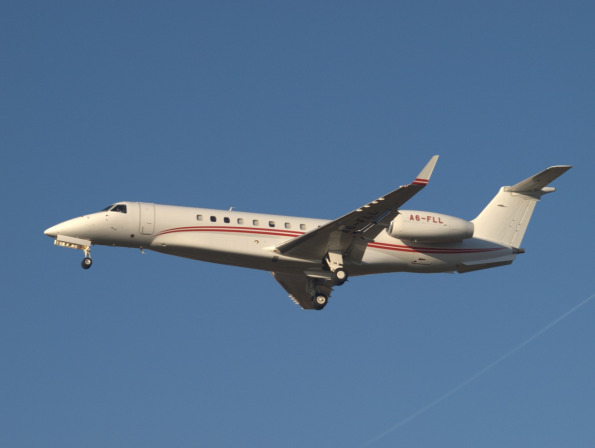
And this is Falcon Aviation Services Embraer ERJ-135BJ Legacy 600.
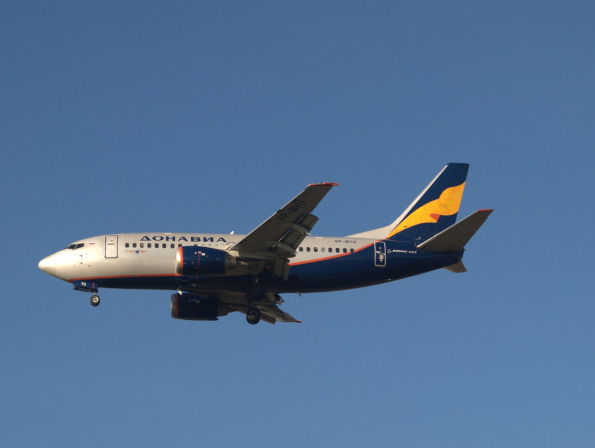
Boeing 737. Followed from Rostov-on-Don to Moscow.
')
This is all, of course, zashib, but in no way beats spotting inside the airport. And this fall my dream came true! I got to such an event. And, moreover, it is very simple: all I did was fill it in time and send the questionnaire. And when I saw my name on the list of accredited people, I jumped to the ceiling. And I'm not joking.
So why is it so cool? Enough to see this picture here.
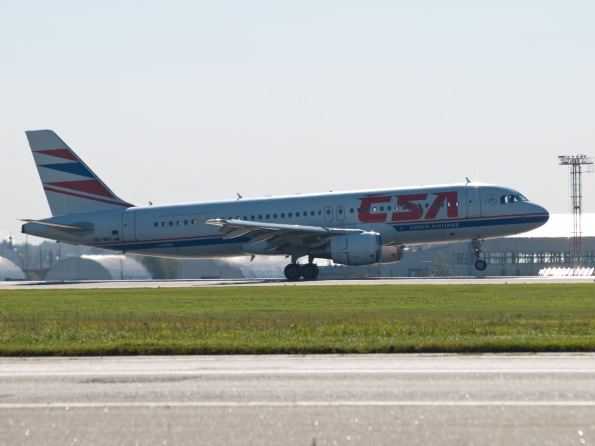
This is real beauty! Such iron bird sits in ten meters from you ... Where else can you take a picture of this?
Here are a couple of images from the autumn spotting in Sheremetyevo.
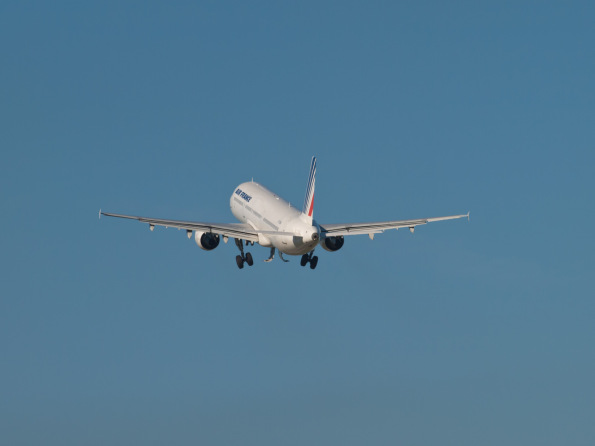
A321 removes the chassis after takeoff. Flight - AF 1145, Paris.

And at the airport there are traffic jams. :)
Radarspotting
For starters - a small screenshot of the site flightradar24.com.

Yes, these are real planes. Their position changes in real time. That's exactly the number of aircraft currently in the air over Europe and the central part of Russia.
The map shows the position of all vessels equipped with an ADS-B transmitter.
ADS-B - Automatic dependent surveillance-broadcast. This is such a hardware and software system that is installed in almost every aircraft now and transmits information about the coordinates, speed, flight level (flight altitude), course, ICAO aircraft code and aircraft identification code (squawk).
There are two modes of operation of ADS-B transmitters.
- Mode-A. The broadcasting frequency is 1030 MHz. Transmitted data on height, squawk and ICAO code of the aircraft. But the coordinates are not transmitted.
- Mode-S. The frequency is also 1030 MHz. But a different type of data transfer is used. In this mode, the coordinates of the vessel are also transmitted.
That's just the second mode is most interesting to us. Just because of the coordinates. Otherwise, what is the use of knowing the speed of a ship and not knowing where it is located? Yes, no.
Fine. The plane transmits this data. But how do we get them? And here it is just that everything is simple and you don’t need to go anywhere. Just go to the site, for example, flightradar24.com and see everything with your own eyes. This site, by the way, has official clients for Android and iOS.
It is enough to open this site in the browser to come as a shock to how many airplanes are currently in the air.
Note that not all airplanes are the same. Some more and some less. In addition to the map, you can still view information about the aircraft. Simply click on an airplane and its route will appear on the map (the color of the trajectory changes depending on the height of the flight), as well as the following data.
- Airline name
- Flight number
- Point of departure
- Destination point
- Type of aircraft
- Aircraft number
- Flight altitude
- Vertical speed
- Horizontal speed
- Hex Code
- Responder Code (squawk code)
- Current coordinates
- The current radar in the zone of which the ship is located
- Cockpit view
Cockpit View is a very interesting option. It loads the Google Earth plugin and displays on it what the view from the cockpit would be. But, unfortunately, this option only works under Windows and Mac OS X. It looks like this:
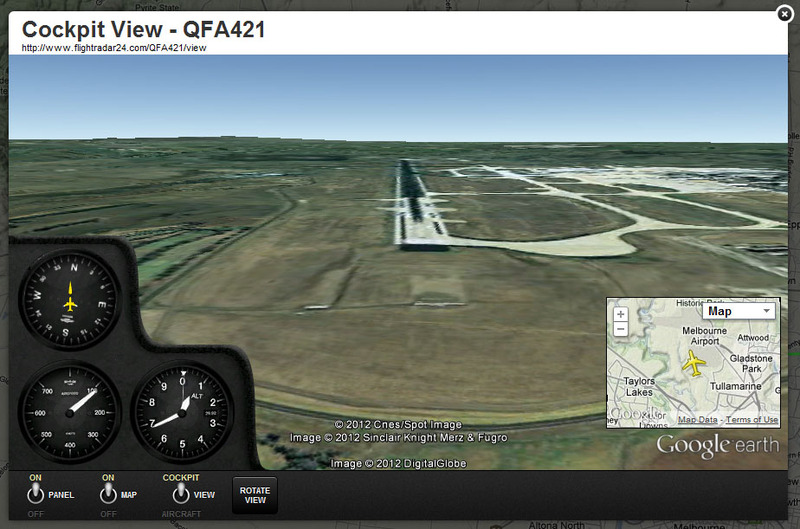
Taken from doctaron.wordpress.com/.
The attentive reader will ask: “Tell me, the author, but how does the site receive signals from ADS-B transmitters?”.
And with the help of ADS-B receivers, dear attentive reader. And you can buy absolutely no problem on ibei and similar sites. But, honestly, I would not recommend taking them, because such dongles are expensive and narrowly focused. And here in Habré at the end of the summer there were two wonderful articles about TV tuners with a wide range of reception. With the help of such pieces you can watch football and listen to your favorite song on the radio and receive an ADS-B signal.
- Radio 60-1700 MHz on RTL2832 for 20 bucks or SDR for Bluewolf beginners
- USB TV tuners on rtl2832 - or how to hear everything on the radio for 600 rubles from BarsMonster
In such tuners used a bunch of Realtek RTL2832U + Elonics E4000. By skipping information on the Internet, E4000 ceased to be released. Therefore, there was a similar configuration Realtek RTL2832U + R820T, working no worse than the first. In order to obtain data from ADS-B transmitters, we need two utilities - gnuradio and gr-air-modes.
After purchasing the receiver and the correct nastoky software, you can get the following image: http://80.69.146.146:3490/VirtualRadar/GoogleMap.htm
Author, why do you need a radio station?
As I wrote at the very beginning, I live next to AP Sheremetyevo. And there are a huge number of stations. My favorite is Sheremetyevo Start / Landing (Sheremetyevo - Precision), which broadcasts at two frequencies - 120.7 MHz and 131.5 MHz.
Having listened to it, you understand how intensive the air traffic is and how nervous the dispatchers work.
You can hear the following:
Nordwind 1563, occupy 25 left.
-I'm taking 25th left. I cross 25 right. Nordwind 1563.
- Ready for takeoff. Nordwind 1563.
Nordwind 1563, I allow takeoff.
-Nordwind 1563, type 25 deko dedum.
-I'm picking Dedum 25 eko. Nordwind 1563.
- Nordwind 1563, work with Moscow-approach at 129.8 MHz.
-I understand you. Thank you bye. Happy New Year. Nordwind 1563.
-Thank you, and you too.
-Thank you.
A description of Sheremetyevo Airport, with all frequencies, can be found at here - http://www.radioscanner.ru/airbase/1.html .
And you can listen to all frequencies online in real time here - http://live.radioscanner.net/audio/32159 .
And I need a radio station, because I do not always have internet, but I always want to listen.
And I heard that you can get the exact weather ... Is that so?
Yes it is. There are two such things - METAR and TAF.
METAR , (METeorological Aerodrome Report) is a meteorological code for transmitting actual weather reports at an aerodrome. This code contains data on wind speed and direction, visibility range, atmospheric phenomena, cloudiness, air temperature, dew point, atmospheric pressure, plus the state of the runway. Updated once every 30 minutes.
TAF - Terminal Aerodrome Forecast - a forecast of 24 hours or less. Valid for 8 km area around the airport.
You can get the METAR and TAF codes from the Ubuntu Linux command line if you install the metar application from the repository.
And then enter in the terminal
metar UUEE Here UUEE is the airport Sheremetyevo code. The output of the application will be something like this:
UUEE 292300Z 29006MPS 9999 OVC011 M05/M07 Q1014 NOSIG RMK 25420227 75450527 I do not know who can understand this. Well, except for the pilots and dispatchers. Therefore, we should run the application with the -d key. And the METAR code will be automatically decrypted and presented in this form:
UUEE 292300Z 29006MPS 9999 OVC011 M05/M07 Q1014 NOSIG RMK 25420227 75450527 Station : UUEE Day : 29 Time : 23:00 UTC Wind direction: 0 (N) Wind speed : 0 Wind gust : 0 Visibility : 9999 M Temperature : -5 C Dewpoint : -7 C Pressure : 1014 hPa Clouds : OVC at 1100 ft Phenomena : On this I want to bow out and wish everyone a happy New Year! I hope you were interested in reading my article and you will also get sick by airplanes like me. :)
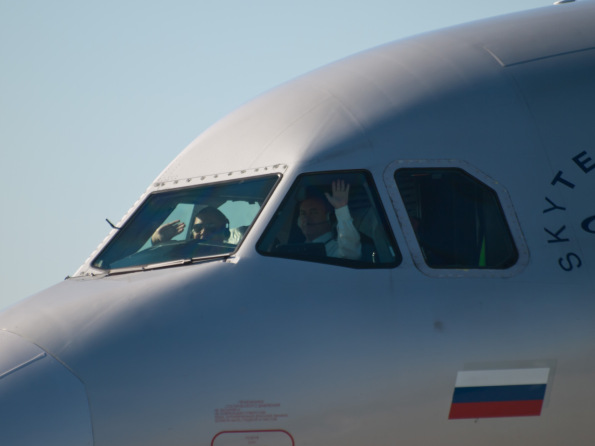
Links
http://pilotseye.tv/ - unrealistic films about flights!
flightstats.com - statistics. Airplanes, airports, airlines. Delays, arrival and departure timetables.
www.radarspotters.eu/forum/index.php - Radar Spotting Forum
Source: https://habr.com/ru/post/156477/
All Articles